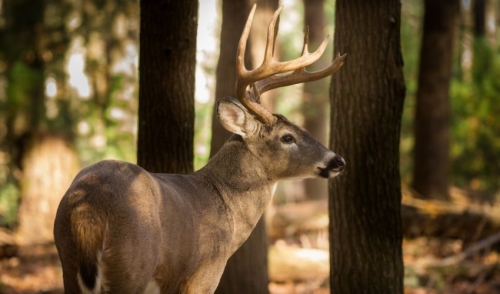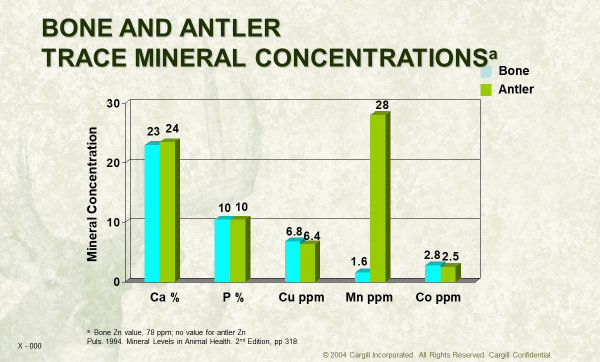
Whitetail Deer Mineral Supplementation
Protein and energy are typically the main topics of discussion when it comes to supplementing whitetail deer, but I am also often asked “should I be feeding free-choice mineral to my deer?”. There are a lot of variables that can come into play when it comes to mineral supplementation, and actually seeing a response, aside from just attracting deer. Most people believe that if deer eat something they put out it must be good for them and they needed it. While I do believe deer exhibit some of this behavior, a lot of the products I see marketed as mineral supplements are typically 90+% salt or commodity based attractants that have little to no actual mineral fortification. Deer will readily consume these types of products, but you will typically not see much in the way of improvement from an antler production standpoint. Most of these products typically contain small amounts of mineral because its expensive to add absorbable sources and raw mineral is not palatable.
If you are already properly supplementing deer with a free-choice balanced diet, it likely includes mineral in the formula. There may not be a need to add a mineral program to improve antler production. It is important to mention that I do not recommend feeding free-choice mineral to animals in confinement. No should you add mineral to a complete diet that is formulated properly, as it could limit intake or create mineral antagonism issues. Auburn University actually conducted a four year study to see if they could determine any difference in body size or antler development in this scenario and found there was no difference in the group that was provided additional mineral.
That being said, deer do need mineral as growing antler is composed of 80% protein and 20% mineral. Hardened antler is usually at least double that when it comes to mineral concentration. While calcium is typically not limiting in the natural diet, phosphorus and other trace minerals important to development and reproduction typically are. While they will pull mineral from their bodies, these minerals are not produced internally and have to come from somewhere in the diet. Below is a graph showing bone and antler mineral concentrations for whitetail deer to demonstrate importance.

So back to the real question, “Should I Feed Mineral To My Pasture Deer?” my answer is definitely YES! While I do not believe feeding mineral alone will work anywhere close to what providing a balanced diet offered free-choice will do, there are some obvious benefits to utilizing both together. First, deer have a natural sodium deficiency due to the high potassium and water content of forages in spring and summer. While we can usually meet this with minimums in a complete ration, deer will also seek out other sources and that is why they will readily consume salt or products with a high salt content during this time. The trick is providing a mineral product that has enough salt to get deer to consume it, while at the same time providing the other minerals listed above in a high enough balanced concentration to possibly see some improvement in antler production. Secondly, managers often forget about how increased mineral consumption could affect doe fertility as this is a variable that is hard to measure in a free range scenario with much significance. While data on whitetail is limited, there are plenty of studies demonstrating how mineral supplementation can benefit fertility in other species. It’s hard not to believe we wouldn’t see a similar response with a deer herd.
Mineral supplementation is attractive because it’s typically less labor intensive and definitely not as expensive as providing a balanced free-choice ration. While you will not see the same results with mineral alone, I do believe it is a good year round addition to any program. Most want to quit supplementing with mineral during the fall and winter and I believe that is the biggest mistake. Deer have used up most of the reserves they had from a mineral standpoint for antler production and lactation once we get through September. So it stands to reason that providing mineral during fall and winter to replenish those reserves could give them a head start when spring rolls around. While I can understand cutting back from a free-choice balanced ration standpoint due to the cost, why wouldn’t you want to keep out mineral especially when they don’t consume much and you can just pour it on the ground?
Just like anything, you will get out of it what you put into it. My best recommendation is to look for products that aren’t as high in salt and are fortified with higher levels of phosphorus and other trace minerals l mentioned to a point where deer will still consume them. Keep these products out free-choice year round at established mineral sites and replenish as necessary. Remember that deer should only be consuming an ounce or so per day on average of a true mineral supplement. If they hammer it year round, you are probably providing something that is not that nutritionally dense from a mineral concentration standpoint. Do not feed mineral directly next to your protein sites as it could limit intake. Also, do not be that concerned if you are feeding a free-choice diet and deer don’t jump on the mineral. This is a good thing and I still recommend keeping it out as they will eventually hit a deficiency somewhere due to the nutrient profile of our habitat constantly changing.
The feed room is proudly brought to you by Nutrena and Cargill Animal Nutrition. Learn more about us here. You can see the original blog post here.
